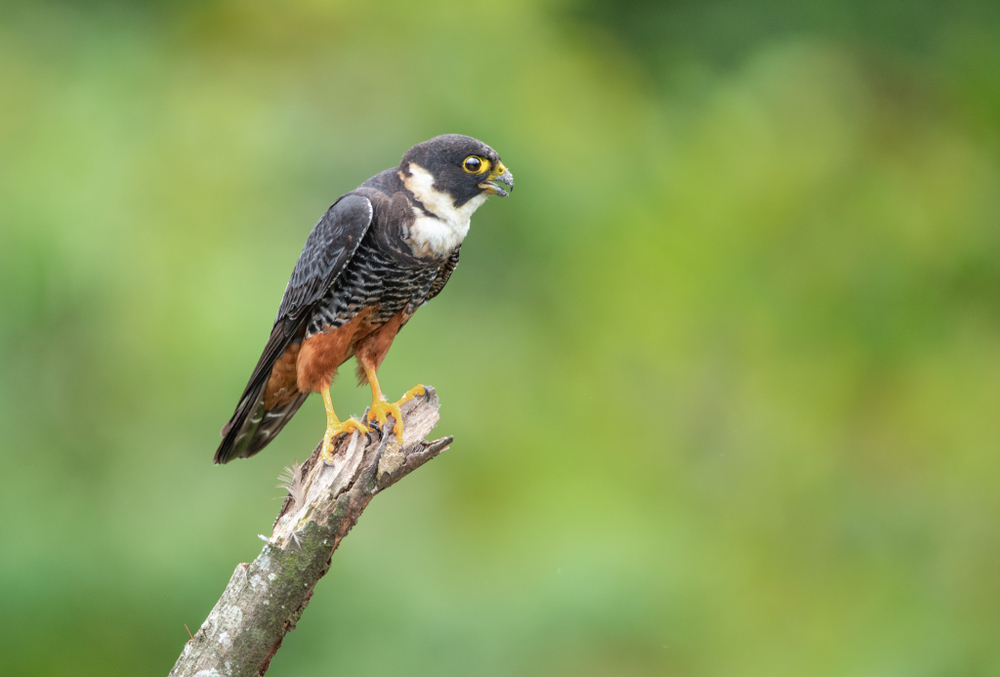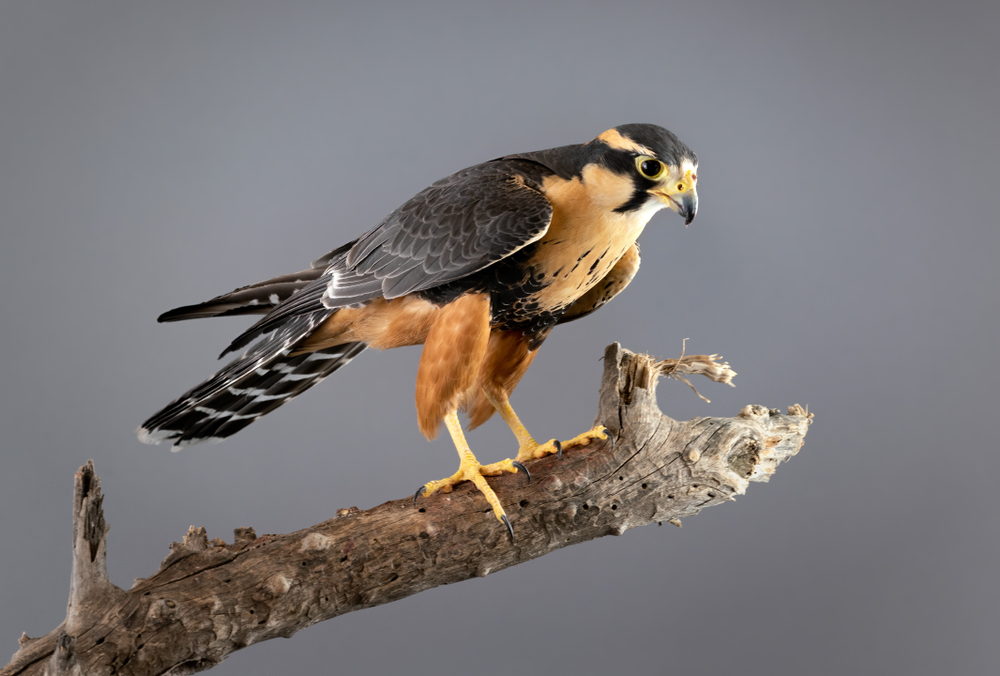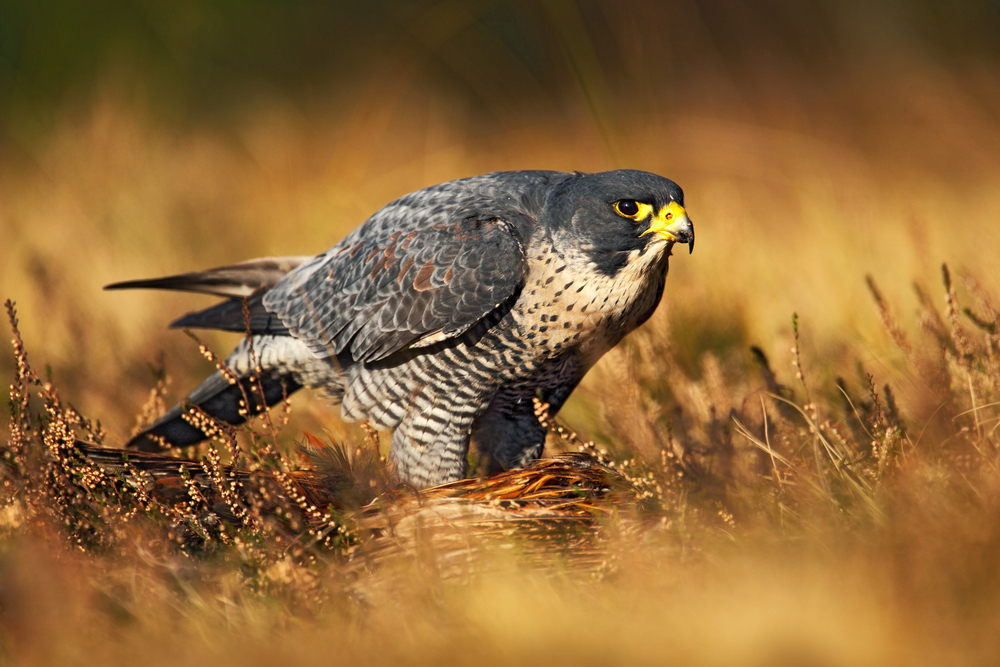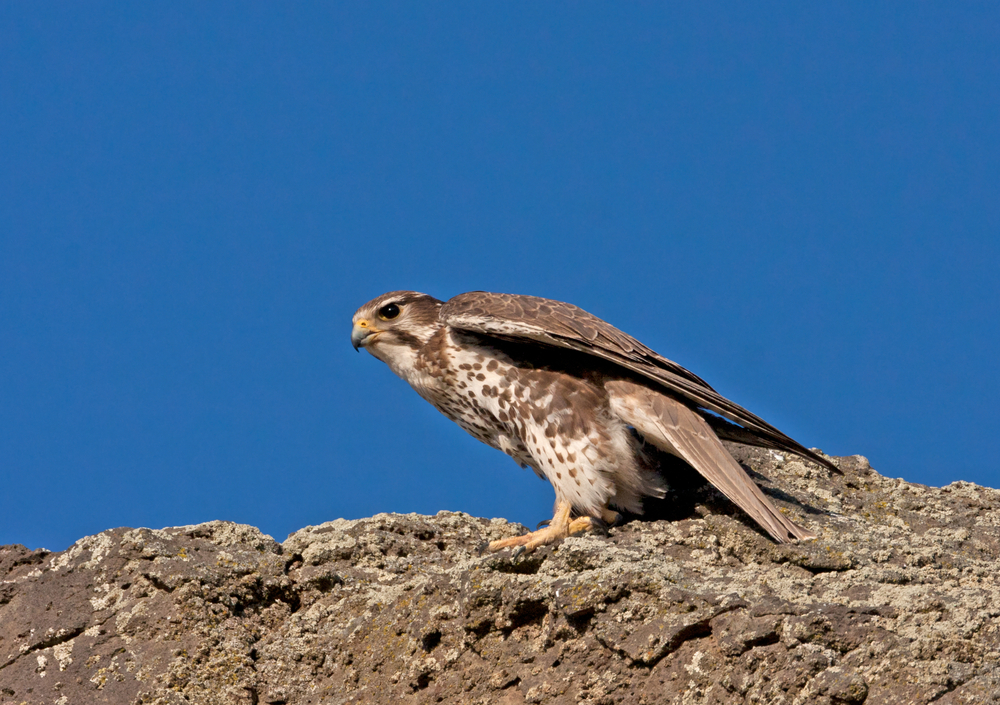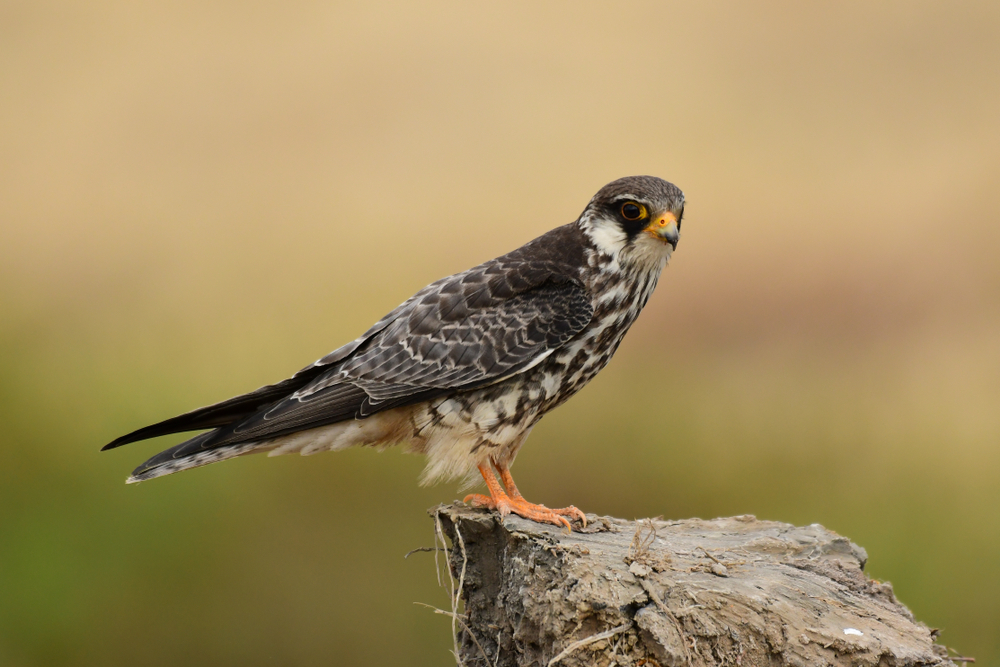The Bat Falcon (Falco rufigularis) is most closely related to the Aplomado Falcon (Falco femoralis) and the Orange-breasted Falcon (Falco deiroleucus), all of which share overlapping ranges in the Americas and similar plumage traits.
About
The Bat Falcon (Falco rufigularis) is a small, powerful raptor of the Falconidae family, found from Mexico through Central America and much of South America. As its name suggests, this falcon frequently hunts bats, but it also preys on birds and large insects, making it a versatile predator of tropical and subtropical ecosystems.
Measuring 23 to 30 centimeters (9 to 12 inches) in length with a wingspan of 51 to 60 centimeters (20 to 24 inches), the Bat Falcon is compact yet muscular. It has a striking plumage pattern: a blackish head and back, a white throat and upper chest, and bold rufous-orange underparts crossed with fine black barring. Its dark face is accented with a sharp white line along the throat, and its long, pointed wings mark it as a swift aerial hunter.
True to its name, the Bat Falcon often hunts at dusk, taking bats in midair with speed and precision. During the day, it also captures small birds, dragonflies, and large beetles in flight, often returning to a perch to consume its catch. This crepuscular hunting behavior distinguishes it from many other falcons.
Breeding usually occurs in tree cavities, cliff ledges, or occasionally old nests of other birds. Females lay two to three eggs, and both parents participate in incubation and feeding. They are known to be attentive and fierce defenders of their nest sites.
The Bat Falcon is currently listed as Least Concern, with stable populations across its wide range. It is a common sight in tropical lowlands, often seen perched on exposed snags or high branches while scanning for prey.
Compact, bold, and beautifully patterned, the Bat Falcon is a dynamic predator of the Neotropics, embodying the agility and power of small falcons.
Physical Characteristics
The Bat Falcon (Falco rufigularis) is a small, compact falcon native to Central and South America, recognized for its bold coloration and swift hunting style.
Plumage:
-
Adults: Glossy blackish upperparts, with a dark hood and throat sharply contrasting against a white or buffy upper chest. The lower chest and belly are richly barred with rufous and white, giving a striking patterned appearance.
-
Juveniles: Browner overall, with more streaking on the chest and less vibrant rufous on the belly.
Head and Face:
The head is rounded with a short, sharply hooked beak. A bold facial pattern includes a black crown, dark eye region, and a white or buff throat patch that stands out against the darker plumage.
Body and Wings:
The Bat Falcon has a stocky build with relatively short, broad wings that enable powerful and quick flight, ideal for pursuing birds and bats in dense habitats or open skies.
Tail:
The tail is medium-length, dark, and banded with narrow white stripes, aiding in aerial maneuverability.
Size:
-
Length: 9.5–12 in (24–30 cm)
-
Wingspan: 22–27 in (56–69 cm)
-
Height at Rest: About 10 in (25 cm) when perched
Weight:
-
Adult Male: 5.6–6.7 oz (160–190 g)
-
Adult Female: 8.1–10.6 oz (230–300 g)
The Bat Falcon’s compact size, glossy black plumage, and barred rufous underparts make it one of the most visually striking falcons of the Neotropics. Its build is perfectly suited for explosive speed and agile mid-air hunting.
Reproduction
The reproductive cycle of the Bat Falcon (Falco rufigularis) follows the pattern of many tropical falcons, with flexible timing depending on regional climate and food availability.
1. Mating and Courtship:
Bat Falcons are generally monogamous, forming strong pair bonds. Courtship includes aerial displays, vocalizations, and prey offerings by the male to the female, which help strengthen the bond before nesting.
2. Nesting Sites:
They do not build their own nests. Instead, Bat Falcons use natural tree cavities, abandoned woodpecker holes, cliff ledges, or occasionally old stick nests left by other birds. Nest sites are typically chosen for their protection and proximity to hunting grounds.
3. Egg Laying:
The female lays 2–4 eggs per clutch. Eggs are buffy or cream-colored, mottled with reddish-brown markings.
4. Incubation:
Incubation lasts about 30–33 days, with the female doing most of the incubating while the male provides food.
5. Hatching and Care of Chicks:
Chicks hatch covered in white down and are altricial, requiring full parental care. The female broods them closely for the first two weeks, while the male continues to deliver prey. Later, both parents share feeding duties.
6. Fledging and Independence:
Young Bat Falcons fledge at about 5–6 weeks of age. After fledging, juveniles may remain near the parents for several additional weeks as they practice flying and hunting before becoming fully independent.
7. Breeding Frequency:
Bat Falcons usually raise one brood per year, with timing adapted to local rainy or dry seasons to ensure abundant prey availability.
The Bat Falcon’s use of natural cavities and its reliance on teamwork between the male and female during breeding increase the survival rate of chicks in its tropical range.
Lifespan
The lifespan of the Bat Falcon (Falco rufigularis) is influenced by the challenges of tropical ecosystems, predation, and environmental pressures, with survival varying between the wild and captivity.
Lifespan in the Wild:
Bat Falcons typically live 7–10 years in the wild. However, many juveniles do not survive their first year due to predation, food scarcity, and competition with larger raptors. The oldest documented wild individuals have lived slightly longer than a decade.
Lifespan in Captivity:
In protected environments with steady food supplies and veterinary care, Bat Falcons may live 12–16 years. The absence of predators and environmental hazards contributes to their longer lifespan under human care.
Threats to the Bat Falcon:
-
Predation: Eggs and chicks are vulnerable to snakes, monkeys, and larger raptors.
-
Habitat Loss: Deforestation and agricultural expansion reduce the availability of nest sites and prey.
-
Human Disturbance: Logging, land conversion, and infrastructure development near nesting areas can disrupt breeding success.
-
Pesticides: Chemicals that affect insect and small bird populations indirectly reduce food availability.
-
Climate Change: Altered rainfall patterns can affect prey abundance during key breeding periods.
Conservation of tropical forests and reduction of pesticide use are vital to supporting healthy Bat Falcon populations throughout their range.
Eating Habits
The Bat Falcon (Falco rufigularis) is a swift and powerful aerial predator, specializing in catching birds and bats on the wing but also feeding on a range of prey.
Diet:
-
Bats: As their name suggests, bats form an important part of their diet, particularly during dusk and dawn flights.
-
Birds: Small to medium-sized birds such as swallows, tanagers, and doves make up a large portion of their prey.
-
Insects: Large insects like dragonflies, beetles, and grasshoppers are frequently taken, especially in the dry season.
-
Small Vertebrates: Occasionally feed on lizards, frogs, and rodents when available.
Hunting Strategy:
-
Aerial Pursuit: Bat Falcons excel at high-speed chases, launching from a perch to intercept birds or bats mid-flight.
-
Perch-Hunting: They often hunt from exposed perches such as snags or utility poles, scanning for flying prey before launching an attack.
-
Crepuscular Activity: They are especially active at dawn and dusk, timing their hunts with peak bat and bird movement.
Feeding Behavior:
-
Prey is typically killed swiftly with a strong bite to the neck or head.
-
Smaller prey may be eaten in flight, while larger prey is carried back to a perch for plucking and consumption.
-
During breeding, males deliver prey to females and chicks, sometimes performing mid-air food passes.
Success and Adaptability:
The Bat Falcon’s versatile diet allows it to thrive in a variety of tropical habitats, from forests and savannas to open farmlands. Its ability to hunt bats gives it a niche less exploited by other falcons, making it a unique predator in its range.
Uniqueness
The Bat Falcon (Falco rufigularis) is a striking and specialized falcon with several unique features that set it apart from other raptors.
Specialist Bat Hunter:
True to its name, the Bat Falcon frequently hunts bats in flight—an unusual specialization among falcons. Its speed and agility at dusk and dawn make it highly effective at capturing fast-moving, nocturnal prey.
Compact and Powerful Build:
Despite its small size, the Bat Falcon has a stocky, muscular body and broad wings, giving it explosive speed and maneuverability in aerial pursuits.
Bold Plumage:
Its glossy black upperparts, pale throat, and richly barred rufous belly create one of the most vivid and contrasting appearances among small falcons, making it easily recognizable.
Perch-and-Pounce Strategy:
Unlike falcons that favor long chases, Bat Falcons often hunt from high, exposed perches, launching sudden, rapid attacks on unsuspecting flying prey.
Tropical Range and Adaptability:
Found across Central and South America, the Bat Falcon thrives in forests, savannas, river valleys, and even near human settlements, demonstrating a wide ecological tolerance.
Symbol of Tropical Raptors:
As a small but fearless falcon, it plays an important ecological role in controlling bird, bat, and insect populations, balancing ecosystems in its tropical range.
The Bat Falcon’s bat-hunting behavior, brilliant plumage, and tropical adaptability make it one of the most unique and charismatic small raptors in the Americas.
Be the First to Share Photos of This Species.
FAQ’s
1. What is the species closest to the Bat Falcon?
2. How does the Bat Falcon compare to other falcons?
The Bat Falcon is smaller and stockier than many falcons, specializing in hunting bats and small birds at dawn and dusk. Unlike Peregrines, which rely on high-altitude dives, Bat Falcons use short, explosive flights launched from perches.
3. Which national parks provide the best opportunities to see a Bat Falcon?
Which national parks provide the best opportunities to see a Bat Falcon?
-
Tikal National Park (Guatemala): Often seen perched on Mayan ruins or snags, hunting bats and birds.
-
Manu National Park (Peru): Dense tropical forests provide excellent habitat for Bat Falcons.
-
Darien National Park (Panama): A stronghold for many raptors, including Bat Falcons.
-
Pantanal Matogrossense National Park (Brazil): Open woodlands and wetlands make this a reliable viewing location.



































































